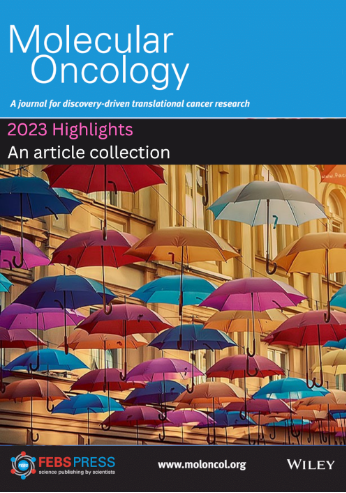花生四烯酸是卵巢癌微环境中的一种临床不良介质,通过扰乱脂筏结构损害巨噬细胞中的JAK - STAT信号
IF 5
2区 医学
Q1 ONCOLOGY
引用次数: 7
摘要
卵巢癌的生存与肿瘤微环境中免疫抑制CD163highCD206high的肿瘤相关巨噬细胞(tam)的丰度和高水平的花生四烯酸(AA)有关。在这里,我们表明这两种关联在功能上是联系在一起的。转录谱分析显示,tam中CD163和CD206/MRC1的高表达与细胞因子触发信号的抑制密切相关,这反映在AA对单核细胞源性巨噬细胞中干扰素和IL - 6的转录反应受损。这种对促炎信号的抑制是由同源受体的功能障碍引起的,表现为JAK1、JAK2、STAT1和STAT3磷酸化的抑制,以及干扰素受体IFNAR1、STAT1和其他免疫调节蛋白在脂筏中的移位。AA暴露导致游离AA在脂筏中的大量积累,这似乎是至关重要的机制,因为抑制其与磷脂的结合并不影响AA介导的对STAT1磷酸化的干扰。AA对干扰素触发的STAT1磷酸化的抑制作用被水溶性胆固醇逆转,已知水溶性胆固醇可以防止AA对脂筏结构的扰动。这些发现表明,在tam中脂质筏功能的药理学恢复可能有助于开发新的治疗方法。本文章由计算机程序翻译,如有差异,请以英文原文为准。
Arachidonic acid, a clinically adverse mediator in the ovarian cancer microenvironment, impairs JAK‐STAT signaling in macrophages by perturbing lipid raft structures
Survival of ovarian carcinoma is associated with the abundance of immunosuppressed CD163highCD206high tumor‐associated macrophages (TAMs) and high levels of arachidonic acid (AA) in the tumor microenvironment. Here, we show that both associations are functionally linked. Transcriptional profiling revealed that high CD163 and CD206/MRC1 expression in TAMs is strongly associated with an inhibition of cytokine‐triggered signaling, mirrored by an impaired transcriptional response to interferons and IL‐6 in monocyte‐derived macrophages by AA. This inhibition of pro‐inflammatory signaling is caused by dysfunctions of the cognate receptors, indicated by the inhibition of JAK1, JAK2, STAT1, and STAT3 phosphorylation, and by the displacement of the interferon receptor IFNAR1, STAT1 and other immune‐regulatory proteins from lipid rafts. AA exposure led to a dramatic accumulation of free AA in lipid rafts, which appears to be mechanistically crucial, as the inhibition of its incorporation into phospholipids did not affect the AA‐mediated interference with STAT1 phosphorylation. Inhibition of interferon‐triggered STAT1 phosphorylation by AA was reversed by water‐soluble cholesterol, known to prevent the perturbation of lipid raft structure by AA. These findings suggest that the pharmacologic restoration of lipid raft functions in TAMs may contribute to the development new therapeutic approaches.
求助全文
通过发布文献求助,成功后即可免费获取论文全文。
去求助
来源期刊

Molecular Oncology
医学-肿瘤学
CiteScore
12.60
自引率
1.50%
发文量
203
审稿时长
6-12 weeks
期刊介绍:
Molecular Oncology highlights new discoveries, approaches, and technical developments, in basic, clinical and discovery-driven translational cancer research. It publishes research articles, reviews (by invitation only), and timely science policy articles.
The journal is now fully Open Access with all articles published over the past 10 years freely available.
 求助内容:
求助内容: 应助结果提醒方式:
应助结果提醒方式:


